
Canning Downs was the first residential establishment built by a white person on the Darling Downs in Queensland, Australia. It is located a short drive from the town of Warwick and originally extended south east to Killarney and the McPherson Range. The area was first named after the British statesman George Canning by Allan Cunningham.
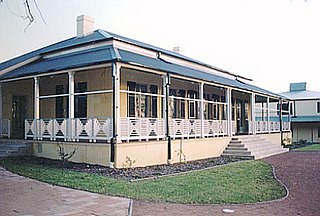
The Homestead is a large, single-storey former homestead and now school at 1a Lionel Street, Georges Hall, New South Wales, Australia, built by David Johnston in 1837. It is listed on the now-defunct Australian Register of the National Estate. It is also known as Georges Hall. The property is owned by Church of the Foursquare Gospel (Aust) Ltd. It was added to the New South Wales State Heritage Register on 2 April 1999.

Millbrook is a heritage-listed detached house at 9 Phillip Street, East Toowoomba, Toowoomba, Toowoomba Region, Queensland, Australia. It was built from 1860s to 1900s. It was added to the Queensland Heritage Register on 27 April 2001.

Victoria Flats is a heritage-listed apartment block at 369 Gregory Terrace, Spring Hill, City of Brisbane, Queensland, Australia. It was designed by architect Thomas Blair Moncrieff Wightman and built c. 1922 by Cheesman & Bull. It is also known as Kilroe's Flats and Morella, Carinyah, Lumtah and Neerim. It was added to the Queensland Heritage Register on 30 March 2001.

Kyeewa is a heritage-listed villa at 1 York Street, East Ipswich, City of Ipswich, Queensland, Australia. It was built c. 1890 for Ernest Greenway. It was added to the Queensland Heritage Register on 21 October 1992.

Gooloowan is a heritage-listed villa at 43 Quarry Street, Ipswich, City of Ipswich, Queensland, Australia. It was designed by architect Charles Balding and built from c. 1864 onwards. It was added to the Queensland Heritage Register on 21 October 1992.
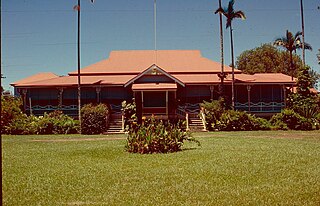
Greenmount Homestead is a heritage-listed homestead at Greenmount Road, Walkerston, Mackay Region, Queensland, Australia. It was designed by William Sykes and built in 1915 by Arthur Carter & Co. It was added to the Queensland Heritage Register on 6 September 1993.

Llanarth is a heritage-listed residence at 120 Eglinton Road, Llanarth, Bathurst Region, New South Wales, Australia. It was built from 1858 to 1864, the original house by W. Atkins and the 1864 alterations by John Smith. The 1907 stables were designed by J. J. Copeman. It is also known as Strathden and Stratheden. It was added to the New South Wales State Heritage Register on 2 April 1999.

Berrilea is a heritage-listed residence at 29 Summer Street, Orange, City of Orange, New South Wales, Australia. It was designed by John Job Copeman and built by J. H. Gain. It is also known as Berrilee and Tabratong. The property is owned by the Uniting Church in Australia. It was added to the New South Wales State Heritage Register on 2 April 1999.
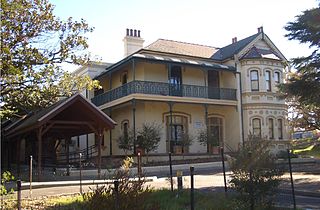
Cairnsfoot is a heritage-listed former residential villa and special school at 18 Loftus Street, Turrella, Bayside Council, New South Wales, Australia. It was built from 1880 to 1884 by Edward M. Farleigh. It has also been known as Cairnsfoot Special School, Loftus Street Special School and Loftus Street Public School. It was added to the New South Wales State Heritage Register on 2 April 1999.

The Horsley complex is a heritage-listed former vineyard, orchard, horse breeding farm and stock breeding farm and now residence and pastoral property at 52–58 Jamieson Close, Horsley Park, City of Fairfield, New South Wales, Australia. It was built from 1805 to 1832. It is also known as Horsley complex , Horsley Park, King's Gift and Horsley House. It was added to the New South Wales State Heritage Register on 2 April 1999.
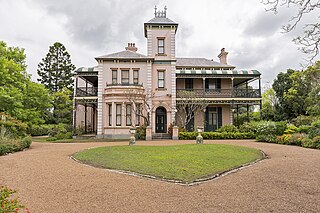
Cintra House is a heritage-listed residence and one-time private hospital at 34 Regent Street, Maitland, City of Maitland, New South Wales, Australia. It was designed by John Wiltshire Pender with a garden by Sydney landscape architect R. Culbert. It was built from 1879 by Robert James with an 1887 extension by H. Noad. It is also known as Cintra. It was added to the New South Wales State Heritage Register on 31 August 2012.

Riverview House is a heritage-listed former orchard and now residence at 135 Marsden Road, West Ryde in the City of Ryde local government area of New South Wales, Australia. It was built from 1860 to 1878 by George Spurway. The property is privately owned. It was added to the New South Wales State Heritage Register on 2 April 1999.

Laurelbank is a heritage-listed former residence and now function centre at 85–87 Penshurst Street, Willoughby, City of Willoughby, New South Wales, Australia. It was built from 1850 to 1884. The property is owned by the Laurelbank Masonic Centre Pty Ltd, a community group. It was added to the New South Wales State Heritage Register on 2 April 1999.

Don Bank is a heritage-listed former residence and now house museum at 6 Napier Street, North Sydney, New South Wales, Australia. It was built from 1853 to 1858 for Edward Wollstonecraft. It is also known as St. Leonard's Cottage. The property is owned by North Sydney Council. It was added to the New South Wales State Heritage Register on 2 April 1999.
Jellore Cottage is a heritage-listed house at 16 Jellore Street, Berrima, Wingecarribee Shire, New South Wales, Australia. It is also known as Munday Cottage. It was added to the New South Wales State Heritage Register on 2 April 1999.
Mail Coach Inn is a heritage-listed former inn and residence at 24 Jellore Street, Berrima, Wingecarribee Shire, New South Wales, Australia. It was built from 1833 to 1841. It is also known as the Royal Mail Coach Inn. It traded in recent times as a now-closed bed and breakfast known as the Coach and Horses Inn; however, that name historically referred to a different Berrima hotel. It was added to the New South Wales State Heritage Register on 2 April 1999.

Davisville is a heritage-listed former YWCA women's home, residence and commune and now residence and bed and breakfast at 63-67 Falls Road, Wentworth Falls, City of Blue Mountains, New South Wales, Australia. It was built from 1888 to 1920 by David Davis, Sydney builder. It is also known as Rennie House. It was added to the New South Wales State Heritage Register on 2 April 1999.

Milton Terrace is a heritage-listed series of terrace houses located at 1–19 Lower Fort Street, in the inner city Sydney suburb of Millers Point in the City of Sydney local government area of New South Wales, Australia. It was built from 1880 to 1882. The property was added to the New South Wales State Heritage Register on 2 April 1999.
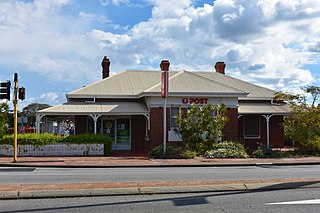
South Perth Post Office is a heritage-listed post office at 103 Mill Point Road, South Perth, Western Australia, Australia. It was added to the Australian Commonwealth Heritage List on 8 November 2011.





















